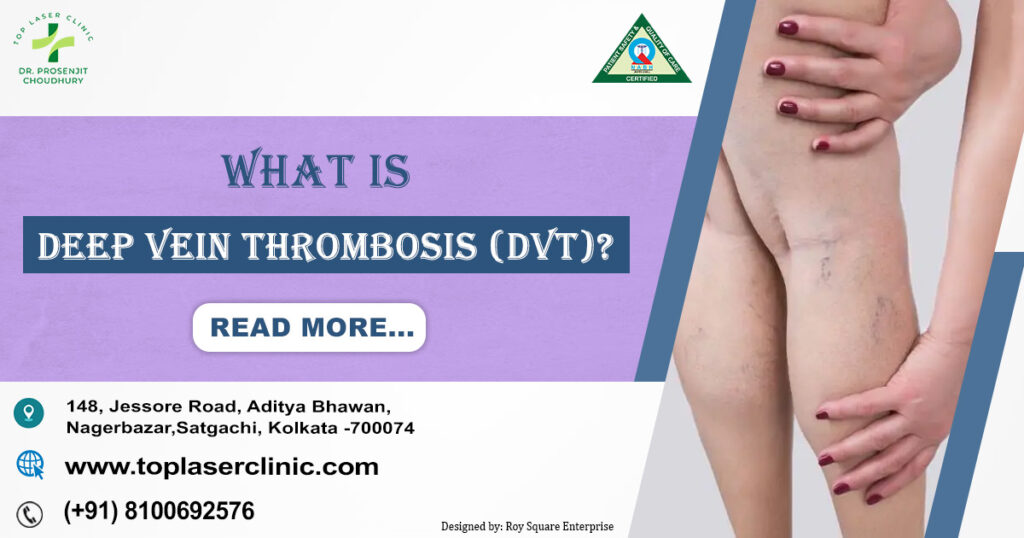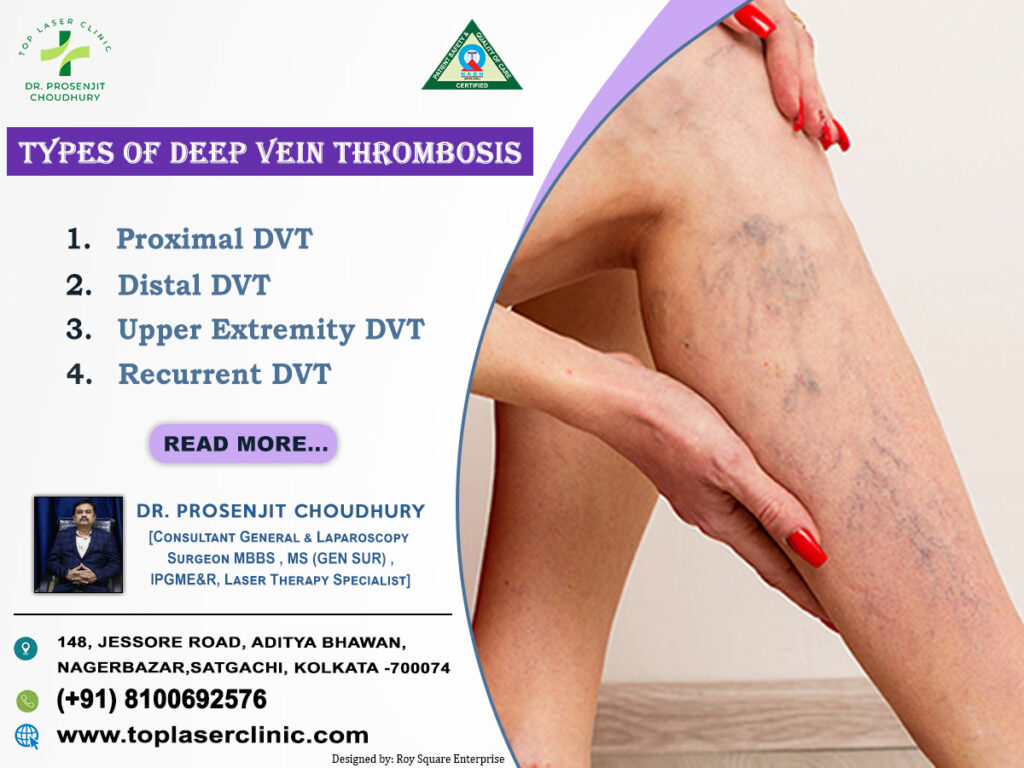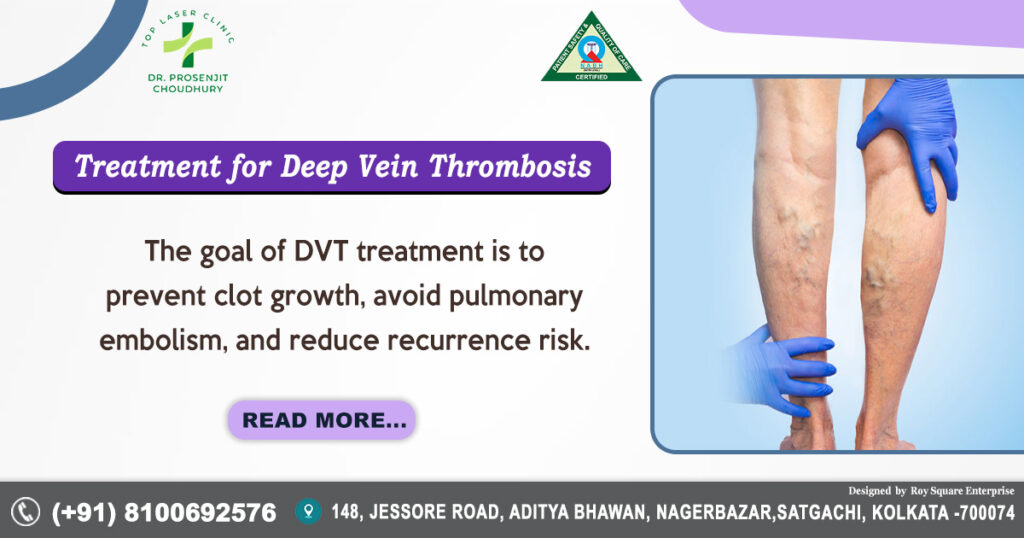Deep Vein Thrombosis (DVT) is a serious medical condition that occurs when a blood clot forms in the deep veins, usually in the legs. While it may sound harmless at first, if left untreated, the clot can travel to the lungs and cause a life-threatening condition called pulmonary embolism (PE). This is why early detection, diagnosis, and proper treatment are crucial.
In this detailed guide, we will explain everything you need to know about DVT—from symptoms, causes, risk factors, types, diagnosis, treatment, and recovery, to myths vs facts and FAQs. We will also highlight expert guidance from Dr. Prosenjit Choudhury, Consultant General & Laparoscopy Surgeon | MBBS, MS (Gen Surg.), IPGME&R | Best in Laser & Minimally Invasive Surgery, at Top Laser Clinic, who has vast experience in managing vascular and surgical conditions with advanced minimally invasive techniques.

What is Deep Vein Thrombosis (DVT)?
DVT occurs when a blood clot (thrombus) develops in a deep vein, commonly in the legs or pelvis. These clots partially or completely block blood flow, leading to swelling, pain, and in severe cases, complications like pulmonary embolism.
Symptoms of Deep Vein Thrombosis
The symptoms of DVT vary depending on the location and severity of the clot.
Common Symptoms:
- Swelling in one leg (rarely both legs).
- Pain or tenderness in the calf or thigh.
- Warmth in the affected leg.
- Redness or skin discoloration.
- Leg cramps, often starting in the calf.
- Heavy or aching feeling in the leg.
Severe Symptoms (Need Immediate Medical Help):
- Shortness of breath.
- Chest pain.
- Coughing up blood (sign of pulmonary embolism).

Types of Deep Vein Thrombosis
- Proximal DVT – Involves veins in the thigh or pelvis; higher risk of pulmonary embolism.
- Distal DVT – Affects calf veins; less dangerous but can progress upward.
- Upper Extremity DVT – Rare, occurs in arms or shoulders, often linked to catheters.
- Recurrent DVT – Reappears after initial treatment.
Causes of Deep Vein Thrombosis
DVT develops due to a combination of factors known as Virchow’s Triad:
- Venous Stasis (Slow Blood Flow):
– Prolonged bed rest, long flights, sitting for hours. - Hypercoagulability (Increased Blood Clotting):
– Genetic clotting disorders, pregnancy, cancer, or certain medications. - Endothelial Injury (Damage to Vein Wall):
– Trauma, surgery, or infections.
Risk Factors for DVT
- Age over 40.
- Family history of clotting disorders.
- Obesity.
- Pregnancy and postpartum period.
- Hormone therapy or birth control pills.
- Smoking.
- Recent surgery or injury.
- Long travel (flights, car rides).
- Varicose veins.
- Chronic diseases (cancer, heart disease, diabetes).
Diagnosis of Deep Vein Thrombosis
Accurate and early diagnosis prevents complications. Common tests include:
- D-Dimer Blood Test – Detects clotting activity.
- Doppler Ultrasound – Most common, non-invasive test.
- Venography – X-ray with dye for detailed imaging.
- MRI/CT scan – Detects clots in deep or pelvic veins.

Treatment for Deep Vein Thrombosis
The goal of DVT treatment is to prevent clot growth, avoid pulmonary embolism, and reduce recurrence risk.
1. Medications
- Anticoagulants (Blood Thinners): Heparin, Warfarin, or newer drugs (DOACs).
- Thrombolytics (Clot Busters): Used in severe cases to dissolve clots.
2. Minimally Invasive Procedures
- Catheter-directed Thrombolysis: A catheter delivers clot-dissolving drugs directly.
- IVC Filter: Prevents clots from reaching the lungs.
- Laser & Endo venous Treatments: Advanced techniques offered at Top Laser Clinic by experts like Dr. Prosenjit Choudhury for safe, effective care.
3. Lifestyle Management
- Wearing compression stockings.
- Regular physical activity.
- Weight management.
- Quitting smoking.
Recovery from Deep Vein Thrombosis
- Hospital Stay: Most patients can be treated as outpatients; severe cases may need hospitalization.
- Activity: Gentle walking is encouraged; avoid long immobility.
- Medication Duration: Blood thinners may be needed for 3–12 months or longer.
- Lifestyle Changes: Healthy diet, hydration, and exercise help prevent recurrence.
- Follow-ups: Regular monitoring with ultrasound and blood tests.
According to Dr. Prosenjit Choudhury at Top Laser Clinic, patients who undergo minimally invasive DVT treatments experience faster recovery, minimal discomfort, and long-term protection against recurrence.
Complications of Untreated DVT
- Pulmonary Embolism (PE): Clot travels to lungs; life-threatening.
- Post-Thrombotic Syndrome (PTS): Chronic leg swelling, pain, and ulcers.
- Recurrent DVT: Higher risk after the first clot.
- Venous Insufficiency: Damaged veins leading to poor circulation.
Top 10 Myths vs Facts About DVT
- Myth: Only elderly people get DVT.
Fact: Anyone can develop DVT, even young adults. - Myth: DVT only occurs after surgery.
Fact: It can also occur due to long travel, obesity, or genetic disorders. - Myth: Blood thinners dissolve clots.
Fact: They prevent new clots but don’t dissolve existing ones. - Myth: Walking worsens DVT.
Fact: Light activity improves circulation and helps recovery. - Myth: DVT is not serious.
Fact: Untreated DVT can cause pulmonary embolism, which is life-threatening. - Myth: Compression stockings are unnecessary.
Fact: They reduce swelling and prevent complications. - Myth: DVT always causes visible swelling.
Fact: Some cases are silent and detected only by scans. - Myth: Only obese people get DVT.
Fact: Slim, active people can also develop clots. - Myth: Surgery for DVT is risky.
Fact: Minimally invasive and laser-assisted procedures are safe and effective. - Myth: Once treated, DVT never returns.
Fact: Recurrence is possible, so lifestyle changes and follow-ups are vital.
Top 10 FAQs About Deep Vein Thrombosis
- What are the first signs of DVT?
– Swelling, pain, warmth, and redness in the leg. - Can DVT be prevented?
– Yes, by staying active, hydrated, and avoiding prolonged immobility. - Is DVT life-threatening?
– Yes, if the clot travels to the lungs (pulmonary embolism). - How is DVT diagnosed?
– Doppler ultrasound and D-dimer blood tests are commonly used. - Can DVT be treated without surgery?
– Yes, many cases are managed with medications. - Do I need to stay in hospital for DVT treatment?
– Not always; many patients are treated on an outpatient basis. - Can exercise cure DVT?
– No, but regular activity improves circulation and prevents recurrence. - Who is the best doctor for DVT treatment?
– Dr. Prosenjit Choudhury at Top Laser Clinic, an expert in laser & minimally invasive surgery. - What foods help prevent DVT?
– High-fibre foods, leafy greens (unless restricted with blood thinners), omega-3-rich foods. - Can DVT return after treatment?
– Yes, recurrence is possible, especially without preventive care.
Why Choose Dr. Prosenjit Choudhury & Top Laser Clinic for DVT Treatment?
- Expertise in laser and minimally invasive surgery.
- Advanced facilities at Top Laser Clinic.
- Faster recovery and reduced complications.
- Personalized patient care and long-term follow-up.
- Proven track record of successful vascular surgeries.
Conclusion
Deep Vein Thrombosis (DVT) is a serious condition that requires timely diagnosis and treatment. With advanced medical care, lifestyle changes, and expert surgical guidance, patients can recover fully and prevent complications.
For the best care in managing DVT, consult Dr. Prosenjit Choudhury, Consultant General & Laparoscopy Surgeon | MBBS, MS (Gen Surg.), IPGME&R | Best in Laser & Minimally Invasive Surgery, at Top Laser Clinic. His expertise ensures safe, effective, and patient-centred treatment for long-term health.